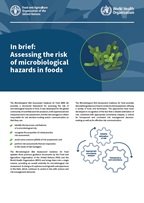Roster of experts
JEMRA is tasked with the evaluation of different aspects of microbiological hazards in the food supply. This roster consists of scientific experts who have submitted applications in response to public calls for experts on Risk Assessment of Microbiological Hazards related to food safety. The applications were reviewed by the FAO and WHO Secretariats and by an external referee, and selections made on the basis of the criteria outlined in the call for experts. Scientists of the roster will be considered for future meetings of JEMRA according to expertise required for the respective meetings.
Past call for experts and data
All →Events
All →

Microbiological
Risk Assessment series
(MRA)
Latest MRA series
Safety and quality of water used in the production and processing of fish and fishery products: meeting...
In 2020, the 43rd Session of the Codex Alimentarius Commission approved the “Development of Guidelines for the Safe Use and Reuse of Water in Food...
Safety and quality of water use and reuse in the production and processing of dairy products: meeting...
Water is used for a wide range of activities in the dairy sector, which consumes a substantial volume of first-use drinking water for production processes,...
Prevention and control of microbiological hazards in fresh fruits and vegetables: part 3: sprout: meeting...
In 2019, following a request from the Codex Committee on Food Hygiene (CCFH), the Codex Alimentarius Committee (CAC) approved new work at its 42nd Session...
Publications
Risk assessment of food allergens: part 3: review and establish precautionary labelling in foods of the...
FAO and WHO reconvened a third meeting to review and evaluate the evidence in support of precautionary allergen labelling to address unintended allergen...
Risk assessment of food allergens: part 2: review and establish threshold levels in foods for the priority...
Knowledge of thresholds constitutes a critical requirement to assessing the risk from allergens, as they are a characteristic of the hazard that allergens...
Risk assessment of food allergens: part 1: review and validation of Codex alimentarius priority allergen...
The labelling of food allergens in pre-packaged foods plays a key role in protecting food allergic individuals, as no preventative clinical treatment is...
Technical guidance for the development of the growing area aspects of bivalve mollusc sanitation programmes,...
This document is the outcome of an update of the first edition of the Joint FAO and WHO Technical guidance for the development of the growing area aspects...
Code of practice for fish and fishery product
The Codex Alimentarius, “the food code”, has a fundamental role in protecting consumers all around the world and ensuring fair practices in...
National food control system plays a pivotal role in protecting the health of consumers and ensuring fair practices in food trade. When we are able...
Histamine in Salmonids: joint FAO/WHO literature review
Histamine is a naturally occurring substance that is derived from the decarboxylation of amino acids. It can be present in certain foods containing free...
Technical guidance for the development of the growing area aspects of bivalve mollusc sanitation programmes
The Codex Alimentarius Commission has developed a Standard for Live and Raw Bivalve Molluscs as well as guidance in the Codex Code of Practice for Fish...
Hazard identification, exposure assessment and hazard characterization of Campylobacter spp. in broiler...
The Consultation examined the information provided by the expert drafting groups on hazard characterization and exposure assessment of Vibrio spp. in seafood...
Joint FAO/WHO expert meeting on the public health risks of histamine and other biogenic amines from fish...
Scombrotoxin fish poisoning (SFP) (often called “histamine poisoning”) is caused by ingestion of certain species of marine fish that contain...
On 9–11 July 2012, the World Health Organization (WHO), in collaboration with the Food and Agriculture Organization of the United Nations (FAO)...
The present guidelines are presented in two parts. One part provides guidance for the preparation of Powdered infant formula (PIF) in care settings where...
Benefits and potential risks of the lactoperoxidase system of raw milk preservation: report of an FAO/WHO...
This technical meeting was jointly organised by the Animal Production and the Food Standards and Quality Services of the Food and Agriculture Organization...
Risk assessment of microbiological hazards in foods: report of a Joint FAO/WHO Expert Consultation
The Food and Agriculture Organization of the United Nations (FAO) and the World Health Organization (WHO) convened an Expert Consultation on Risk Assessment...
Brochure


